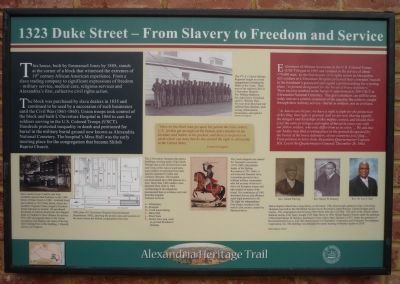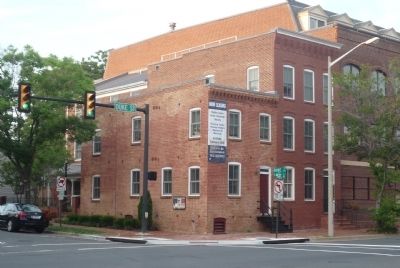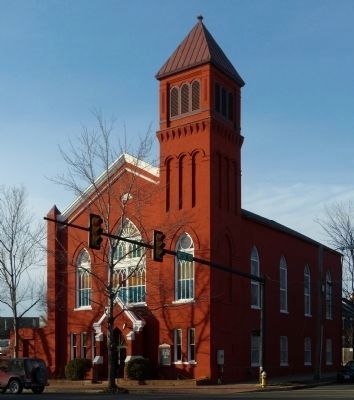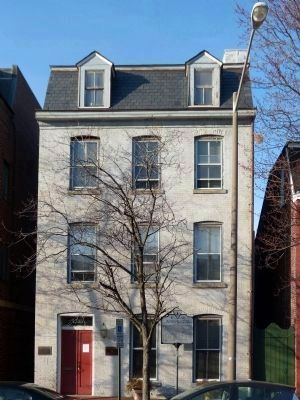Southwest Quadrant in Alexandria, Virginia — The American South (Mid-Atlantic)
1323 Duke Street – From Slavery to Freedom and Service
— Alexandria Heritage Trail —
Inscription.
Text, upper half of marker panel:
This house, built by Emmanuel Jones by 1888, stands at the corner of a block that witnessed the extremes of 19th century African American experience. From a slave trading company to significant expressions of freedom - military service, medical care, religious services and Alexandria’s first, collective civil rights action.
The block was purchased by slave dealers in 1835 and continued to be used by a succession of such businesses until the Civil War (1861-1865). Union troops took control of the block and built L’Ouverture Hospital in 1864 to care for soldiers serving in the U.S. Colored Troops (USCT).
Hundreds protested inequality in death and petitioned for burial in the military burial ground now known as Alexandria National Cemetery. The hospital’s Mess Hall was the early meeting place for the congregation that became Shiloh Baptist Church.
[Photograph of soldiers from E Company, 4th U.S.C.I. at Fort Lincoln near Colmar Manor, MD - 1864]
The 4th U.S. Colored Infantry Regiment fought in several engagements including the Battle of the Crater. Three men of the regiment died at L’Ouverture Hospital: Pvt. William Mathews, Pvt. John Henry Nicholson, and Pvt. William Plato. All were from Maryland and suffered from illnesses, such as lung inflammation, rheumatism, and typhoid. Library of Congress
”Once let the Black man get upon his person the brass letters, U.S., let him get an eagle on his button, and a musket on his shoulder and bullets in his pockets, and there is no power on earth which can deny that he has earned the right to citizenship in the United States.”
Frederick Douglass
Enlistment of African Americans in the U.S. Colored Troops (USCT) began in 1863 and resulted in the service of about 179,000 men. In the first known civil rights action in Alexandria, 423 soldiers in L’Ouverture Hospital protested their comrades’ burials in the freedmen’s graveyard and signed a petition asking for a resting place "in ground designated for the burial of brave defenders." Their success resulted in the burial of approximately 280 USCT in Alexandria National Cemetery. The grave markers can still be seen today and are a solemn statement of the equality the soldiers sought through their military service - burial as soldiers, not as civilians.
“As American citizens, we have a right to fight for the protection of her flag, that right is granted, and we are now sharing equally the dangers and hardships in this mighty contest, and should shair [sic] the same privileges and rights of burial in every way with our fellow solders, who only differ from us in color, … We ask that our bodies
may find a resting place in the ground designated for the burial of the brave defenders, of our countries [sic] flag…”
From petition in letter from Alexandria Quartermaster Captain J.G.C. Lee to the Quartermaster General, December 28, 1864.
Text, lower half of marker panel:
[Photograph of the “Price Burch & Co.” slave market, 1863]
Slave dealers Isaac Franklin and John Armfield opened their business on the 1300 block of Duke Street in 1828. Armfield lived and worked at 1315 Duke Street, where the Northern Virginia Urban League’s Freedom House Museum is located. He purchased thousands of African Americans and shipped them to Franklin in New Orleans for auction. This 1863 photograph dates to the Union occupation and displays the name of the last slave trading firm in this building.
J. Russell, Library of Congress.
1865 plan of L’Ouverture Hospital (Quartermaster Department 1865), showing the project area and location of the mess where the Shiloh congregation first met.
A – Dispensary
B – Hospital
D – Cook house/dining
E – Mess Hall
N - Ward Tents
P – former slave pen, used as jail and freedmen's housing
The L’Ouverture Hospital plan shows buildings covering much of the block. Perhaps due to the elevated floors and roof vents of the canvas ward tents, most soldiers recuperated from their injuries sustained in battle and common illnesses. The hospital accommodated up to 600 patients at a time. More than 1400 soldiers were admitted from 1864 to 1865. Archaeological investigations documented that no evidence survived from the hospital. National Archives
[Painting of Toussaint L’Ouverture on horseback]
The Union hospital was named for Toussaint L’Ouverture (1743-1803), the primary leader of the Haitian Revolution (1791-1804). A self-educated liberated slave, L’Ouverture proved to be a brilliant military commander who led an army of slaves to drive out European armies and take control of much of the island. His constitution of 1801 abolished slavery and affirmed equal legal protection to all. The fight for independence from France resulted in the world’s first country created by liberated slaves.
Shiloh Baptist Church has a long history on the block. Fifty freed people gathered in the L’Ouverture Hospital mess hall as the Old Shiloh Society led by Reverend Leland Warring, Charles Rodgers and E. Owens. The congregation moved across West Street after the Civil War. The clerk of the church, James Ballard, and his wife, Mary, bought 1323 Duke Street in 1920. Shiloh Baptist Church, under the pastorate of Reverend Moses W. Beasley, purchased it from widow Mary Ballard in 1957. Under the pastorate of Rev. Dr. Lee A. Earl, the
church leased it to Harambee Community and Economic Development Corporation, Inc. The building was dedicated for senior housing as Beasley Square in 2010.
[Photos of the Reverands Warring, Beasley, and Earl.] Shiloh Baptist Church
Erected 2011 by City of Alexandria, Virginia.
Topics and series. This historical marker is listed in these topic lists: African Americans • Churches & Religion • Civil Rights • War, US Civil. In addition, it is included in the Virginia, The City of Alexandria series list. A significant historical date for this entry is December 28, 1780.
Location. 38° 48.23′ N, 77° 3.296′ W. Marker is in Alexandria, Virginia. It is in the Southwest Quadrant. Marker is at the intersection of West Street and Duke Street (Virginia Route 236) on West Street. Touch for map. Marker is at or near this postal address: 1323 Duke Street, Alexandria VA 22314, United States of America. Touch for directions.
Other nearby markers. At least 8 other markers are within walking distance of this marker. Franklin and Armfield Slave Office (a few steps from this marker); Shiloh Baptist Church (a few steps from this marker); L'Overture Hospital HQ (about 300 feet away, measured in a direct line); L’Ouverture Hospital (about 400 feet away); Freedom House Museum (about 800 feet away); Capt. James McGuire House (approx. 0.2 miles away); The Growth of Upper King Street (approx. 0.2 miles away); Alexandria, D.C. (approx. 0.2 miles away). Touch for a list and map of all markers in Alexandria.
Also see . . . Alexandria Heritage Trail. (Submitted on December 10, 2013, by Richard E. Miller of Oxon Hill, Maryland.)
Credits. This page was last revised on December 10, 2023. It was originally submitted on August 13, 2011, by Richard E. Miller of Oxon Hill, Maryland. This page has been viewed 2,506 times since then and 48 times this year. Last updated on August 14, 2011, by Linda Walcroft of Woodstock, Virginia. Photos: 1. submitted on August 13, 2011, by Richard E. Miller of Oxon Hill, Maryland. 2. submitted on August 14, 2011, by Richard E. Miller of Oxon Hill, Maryland. 3, 4. submitted on March 16, 2014, by Allen C. Browne of Silver Spring, Maryland. • Bill Pfingsten was the editor who published this page.



